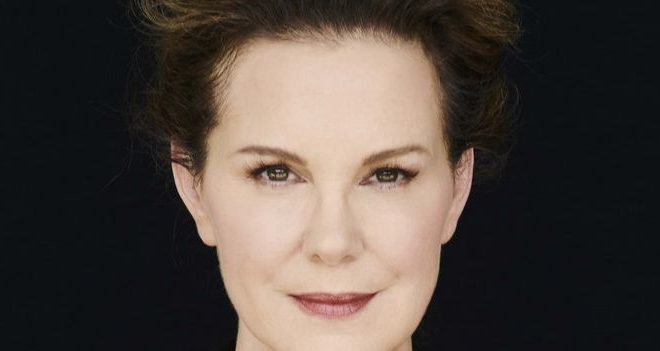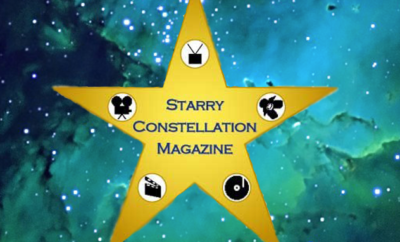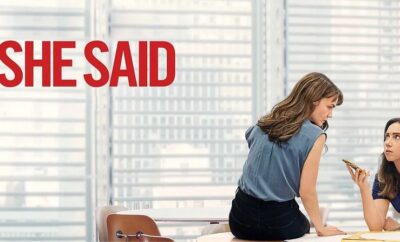
Interviews
Elizabeth Perkins – Sharp Objects
By: Jamie Steinberg
Q) How was Jackie in “Sharp Objects” originally described to you?
A) She was described to me as a “backwoods Barbie” who grew up with Adora (Patricia Clarkson) and has been through the years best friends, enemies and frenemies, but inexplicably bound to each other because Jackie knows everything that goes on in that house. I thought, “Well, that’s interesting. Okay…” If you’ve read the book, when I say “everything that goes on in the house” you know what I mean. Why Jackie doesn’t reveal things or secrets is a whole other story that is not really fleshed out in this series. There is some kind of hold Adora has over her, which doesn’t allow her to speak her truth until very close to the end. Jackie is an alcoholic, so things come out that she can’t keep inside anymore. I think Adora, the daughter Jackie had, I don’t think Jackie had much of a life and sort of looks at Adora’s life upon the hill with the beautiful clothing, the beautiful house and the third husband – that’s all things that Jackie will never have. I think that she’s particularly in love with Camille (Amy Adams) and maybe that’s the reason she didn’t end up getting out when Camille’s sister did not.
Q) Was it difficult then for you to get into character?
A) One of the great things about this particular group of people because you have a chance to work with people like Amy Adams and Patricia Clarkson. That’s a formidable duo on its own, but you put in Gillian Flynn and Marti Noxon and Eliza Scanlen (the female centricity o the entire project) and what ever you have to “go through” while you’re shooting is completely worth it. It was a rough shoot because it was hot. We were in Georgia and you’re in the woods where it was a hundred degrees. All the sweat that you see on the actors, that was real. [laughs] It was a long shoot, we were tired, and it was dark. It was difficult for Amy to inhabit that troubled a person, but we all struggled, and we were all aware that we were inhabiting troubled people. We had a conversation about it. It was hard to embrace Jackie and it was hard to live with Jackie.
Q) Talk about working with Amy Adams.
A) Amy is one of the simplest actors that I’ve ever worked with and I mean “simple” as in she’s so clean with her choices and her method. There is never a time when you see her going through actor machinations to perform. That was a sort of a lesson in less is more for me. She just inhabits and that’s quite astonishing. As one of the executive producers, there was a feeling amongst the actors that there was a safety net there in a “I’m not going to let you fall. I’ll catch you,” net. That sort of helped bond us all and keep us okay within the situation – to know that she was a member of the team as well as the producer. That’s a gift. That’s a gift. The good thing about this project was that we didn’t have any divas. As much as Patricia is playing a diva…[laughs] Usually, there is one in the cast that stands out and we didn’t have that one. It was a lot of comradery and a lot of determination to set the tone that Jean-Marc [Vallée] wanted because he was very specific. For him it’s about tone, texture, temperature, music, smells, tastes, feelings and emotions. I think you can see that when you watch the piece that he’s very much into tone.
Q) What advice did director Jean-Marc Vallée give that took to heart while filming?
A) I think it’s just the nature of how he shapes. Jean-Marc doesn’t believe in light or blocking or rehearsal of any kind. So, for him, it’s all completely organic. And most of what you see on screen was the first time any of us did it; in other words, it’s probably the first time any of us ever did the scene because for him it’s all about the organic response and the lack of acting choices so that it comes from somewhere real and honest without the filtration of “lights, camera, action.” We never really know where his camera is or what he’ll be filming. He can then decide to sort of jump over and put his camera on Patricia or jump over and put his camera on Matt Craven. You just don’t know where he is going to be and so he didn’t really need to say anything because before we shot scenes that was all explained to us at the very beginning like, “This is how I work, and this is how I shoot.” He did the same thing on Dallas Buyers Club and Wild (which he shot with Reese Witherspoon). So, you are pretty aware that is happening and consequently the character becomes alone and whatever you bring to it he steps into. That’s really freeing about that.
Q) It sounds like one of the most challenging and memorable projects of your career.
A) Well, I think everyone involved could say that. Usually, film is so constructed, and it has to be constructed on some levels because you have like ten different departments and everybody has got their hand in it. You have your props, costumes, makeup, hair, lights, this and that. This sort of stripped that all away. Your first response to that is, “Well, no,” until you sort of allow yourself the freedom to experience that and what comes out of that is so organic and so real that now you sort of wonder if you can go back to more traditional styles. It’s challenging in a way that it sort of alters the way you approach your work and that can be hard, but it can also be incredibly freeing. I would imagine it as someone who is a portrait painter and that’s what they did and their comfort zone. Now, someone says, “Well, I’m going to force you to do abstract.” What does that feel like? You can be very resistant to that, but inevitably there is a freedom to that. So, in that way it was challenging, but I wouldn’t want “challenging” to be interpreted as bad because there is a difference.
Q) What did you personally take away from working on “Sharp Objects?”
A) With all of that stripped away, with the lights not being there and the sound not being there and the rehearsal and the blocking – what you take away from that is that it is all about the human emotion. It’s all about that people. It’s not about the training going through the background and this has to be lowered at the exact moment. It’s all about the human interaction and it’s about the actors. There is something about that which is incredibly gratifying. Sometimes you’ll be on a show and you feel like, “I’m just in the midst of a highly composed shot and as long as a jet takes off over my head we’ve got the scene.” [laughs] So, this was really actor-centric and performance-centric. I walk away with a lot of gratitude for that because that doesn’t happen very often.





You must be logged in to post a comment Login